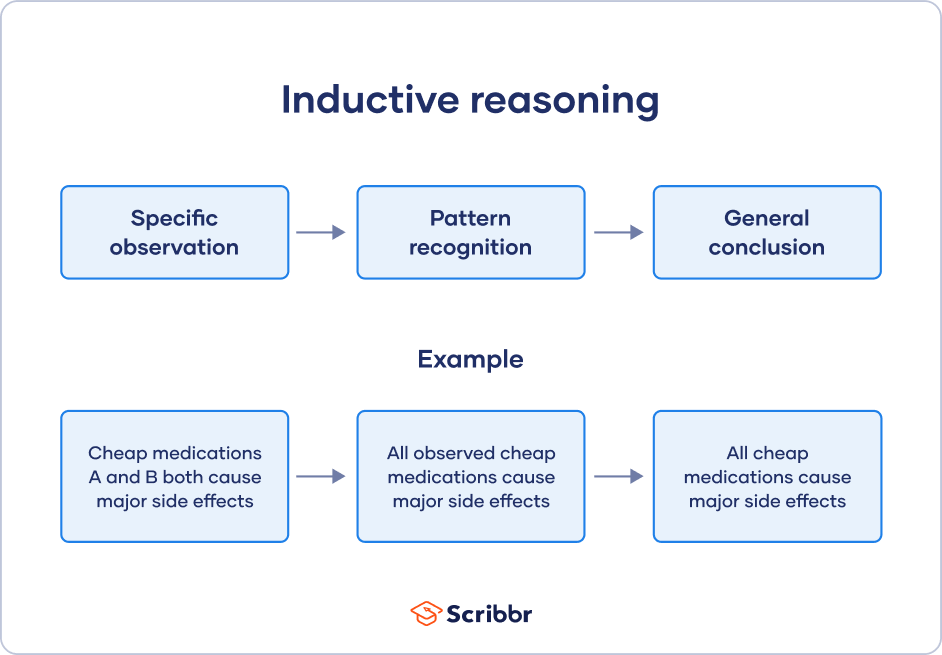Inductive Reasoning | Types, Examples, Explanation
Inductive reasoning is a method of drawing conclusions by going from the specific to the general. It’s usually contrasted with deductive reasoning, where you go from general information to specific conclusions.
Inductive reasoning is also called inductive logic or bottom-up reasoning.
Note: Inductive reasoning is often confused with deductive reasoning. However, in deductive reasoning, you make inferences by going from general premises to specific conclusions.
What is inductive reasoning?
Inductive reasoning is a logical approach to making inferences, or conclusions. People often use inductive reasoning informally in everyday situations.
You may have come across inductive logic examples that come in a set of three statements. These start with one specific observation, add a general pattern, and end with a conclusion.
| Stage | Example 1 | Example 2 |
|---|---|---|
| Specific observation | Nala is an orange cat and she purrs loudly. | Baby Jack said his first word at the age of 12 months. |
| Pattern recognition | Every orange cat I’ve met purrs loudly. | All observed babies say their first word at the age of 12 months. |
| General conclusion | All orange cats purr loudly. | All babies say their first word at the age of 12 months. |
Inductive reasoning in research
In inductive research, you start by making observations or gathering data. Then, you take a broad view of your data and search for patterns. Finally, you make general conclusions that you might incorporate into theories.
You distribute a survey to pet owners. You ask about the type of animal they have and any behavioural changes they’ve noticed in their pets since they started working from home. These data make up your observations.
To analyse your data, you create a procedure to categorise the survey responses so you can pick up on repeated themes. You notice a pattern: most pets became more needy and clingy or agitated and aggressive.
Based on your findings, you conclude that almost all pets went through some behavioural changes due to changes in their owners’ work locations. This is a generalisation that you can build on to test further research questions.
Inductive reasoning is commonly linked to qualitative research, but both quantitative and qualitative research use a mix of different types of reasoning.
Types of inductive reasoning
There are many different types of inductive reasoning that people use formally or informally, so we’ll cover just a few in this article:
- Inductive generalisation
- Statistical generalisation
- Causal reasoning
- Sign reasoning
- Analogical reasoning
Inductive reasoning generalisations can vary from weak to strong, depending on the number and quality of observations and arguments used.
Inductive generalisation
Inductive generalisations use observations about a sample to come to a conclusion about the population it came from.
Inductive generalisations are also called induction by enumeration.
- The flamingos here are all pink.
- All flamingos I’ve ever seen are pink.
- All flamingos must be pink.
Inductive generalisations are evaluated using several criteria:
- Large sample: Your sample should be large for a solid set of observations.
- Random sampling: Probability sampling methods let you generalise your findings.
- Variety: Your observations should be externally valid.
- Counterevidence: Any observations that refute yours falsify your generalisation.
Statistical generalisation
Statistical generalisations use specific numbers to make statements about populations, while non-statistical generalisations aren’t as specific.
These generalisations are a subtype of inductive generalisations, and they’re also called statistical syllogisms.
Here’s an example of a statistical generalisation contrasted with a non-statistical generalisation.
| Statistical | Non-statistical | |
|---|---|---|
| Specific observation | 73% of students from a sample in a local university prefer hybrid learning environments. | Most students from a sample in a local university prefer hybrid learning environments. |
| Inductive generalisation | 73% of all students in the university prefer hybrid learning environments. | Most students in the university prefer hybrid learning environments. |
Causal reasoning
Causal reasoning means making cause-and-effect links between different things.
A causal reasoning statement often follows a standard setup:
- You start with a premise about a correlation (two events that co-occur).
- You put forward the specific direction of causality or refute any other direction.
- You conclude with a causal statement about the relationship between two things.
- All of my white clothes turn pink when I put a red cloth in the washing machine with them.
- My white clothes don’t turn pink when I wash them on their own.
- Putting colourful clothes with light colours causes the colours to run and stain the light-coloured clothes.
Good causal inferences meet a couple of criteria:
- Direction: The direction of causality should be clear and unambiguous based on your observations.
- Strength: There’s ideally a strong relationship between the cause and the effect.
Sign reasoning
Sign reasoning involves making correlational connections between different things.
Using inductive reasoning, you infer a purely correlational relationship where nothing causes the other thing to occur. Instead, one event may act as a ‘sign’ that another event will occur or is currently occurring.
- Every time Punxsutawney Phil casts a shadow on Groundhog Day, winter lasts six more weeks.
- Punxsutawney Phil doesn’t cause winter to be extended six more weeks.
- His shadow is a sign that we’ll have six more weeks of wintery weather.
It’s best to be careful when making correlational links between variables. Build your argument on strong evidence, and eliminate any confounding variables, or you may be on shaky ground.
Analogical reasoning
Analogical reasoning means drawing conclusions about something based on its similarities to another thing. You first link two things together and then conclude that some attribute of one thing must also hold true for the other thing.
Analogical reasoning can be literal (closely similar) or figurative (abstract), but you’ll have a much stronger case when you use a literal comparison.
Analogical reasoning is also called comparison reasoning.
- Humans and laboratory rats are extremely similar biologically, sharing over 90% of their DNA.
- Lab rats show promising results when treated with a new drug for managing Parkinson’s disease.
- Therefore, humans will also show promising results when treated with the drug.
Inductive vs deductive reasoning
Inductive reasoning is a bottom-up approach, while deductive reasoning is top-down.
In deductive reasoning, you make inferences by going from general premises to specific conclusions. You start with a theory, and you might develop a hypothesis that you test empirically. You collect data from many observations and use a statistical test to come to a conclusion about your hypothesis.
Inductive research is usually exploratory in nature, because your generalisations help you develop theories. In contrast, deductive research is generally confirmatory.
Sometimes, both inductive and deductive approaches are combined within a single research study.
Inductive reasoning approach
You begin by using qualitative methods to explore the research topic, taking an inductive reasoning approach. You collect observations by interviewing workers on the subject and analyse the data to spot any patterns. Then, you develop a theory to test in a follow-up study.
Deductive reasoning approach
You start with the general idea that office lighting can affect quality of life for workers. You believe that significant natural lighting can improve office environments for workers. In a follow-up experiment, you test the hypothesis using a deductive research approach.
Frequently asked questions about inductive reasoning
Cite this Scribbr article
If you want to cite this source, you can copy and paste the citation or click the ‘Cite this Scribbr article’ button to automatically add the citation to our free Reference Generator.
Bhandari, P. (2022, December 05). Inductive Reasoning | Types, Examples, Explanation. Scribbr. Retrieved 1 July 2025, from https://www.scribbr.co.uk/research-methods/inductive-reasoning-types/

